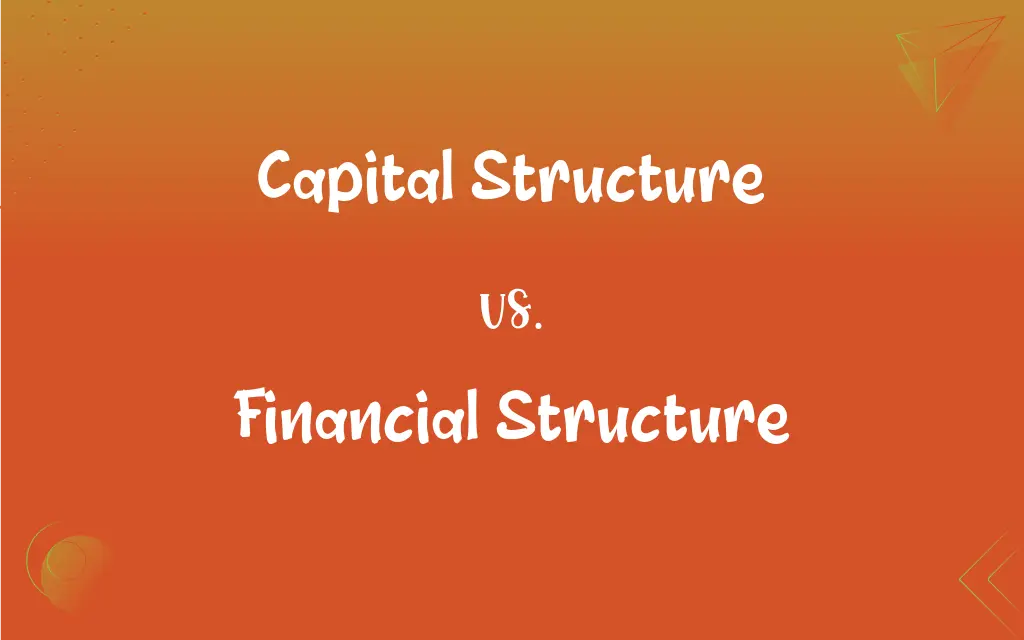Capital Structure vs. Financial Structure: What's the Difference?
Edited by Aimie Carlson || By Janet White || Published on November 13, 2023
"Capital Structure" refers to a company's mix of debt and equity financing, while "Financial Structure" encompasses all of a company's liabilities and equities.

Key Differences
"Capital Structure" pertains specifically to the mix between a company's equity capital (like common and preferred stock) and its debt capital (like bonds and long-term borrowings). Conversely, "Financial Structure" is broader, including not only long-term debt and equity but also short-term borrowings, trade payables, and other short-term liabilities.
A company's "Capital Structure" is central to understanding its risk profile. High debt relative to equity, for instance, can signify greater financial risk, as the firm may face challenges servicing its debt. Meanwhile, the "Financial Structure" provides a comprehensive view of how a company sources its funds, regardless of the time frame, illustrating the entire liability and equity side of the balance sheet.
When considering the "Capital Structure", analysts often reference metrics such as the debt-to-equity ratio to measure financial leverage. The "Financial Structure", on the other hand, includes such considerations but expands to include all financing, giving a complete picture of the company's obligations and ownership.
In essence, while "Capital Structure" zeroes in on the long-term financing choices a company makes, "Financial Structure" offers a holistic view of all sources of funds, irrespective of their duration.
Comparison Chart
Components Included
Long-term debt and equity.
All liabilities and equity.
ADVERTISEMENT
Focus
Mix between debt and equity financing.
Comprehensive view of how a company is financed.
Time Horizon
Primarily long-term.
Both short-term and long-term.
Risk Implications
Indicates financial leverage risk.
Reflects overall financial risk from all obligations.
Analysis Metrics
Debt-to-equity ratio, etc.
Current ratio, total debt ratio, etc.
Capital Structure and Financial Structure Definitions
Capital Structure
The proportionate relationship between debt capital and equity capital.
Startups might have a unique Capital Structure compared to established firms.
ADVERTISEMENT
Financial Structure
A snapshot of all the sources of funds on a firm's balance sheet.
The Financial Structure revealed an increase in short-term borrowings.
Capital Structure
A strategic configuration of a firm's sources of long-term funds.
The CEO discussed potential changes to the Capital Structure at the annual meeting.
Financial Structure
The entire composition of a company's liabilities and equities.
Reviewing the Financial Structure helps understand a company's overall financial health.
Capital Structure
The mix of debt and equity used by a company for financing.
The firm adjusted its Capital Structure by issuing more shares.
Financial Structure
The comprehensive framework of how a business is financed, both short-term and long-term.
Studying the Financial Structure provides insights into a company's liquidity and solvency.
Capital Structure
The balance between a company's long-term debt and shareholder equity.
A skewed Capital Structure can impact a company's creditworthiness.
Financial Structure
All financial obligations and ownership details of an entity.
Changes in the Financial Structure can influence investor perceptions.
Capital Structure
The financial framework outlining how a firm's assets are financed.
Analysts often evaluate a company's Capital Structure to gauge its risk profile.
Financial Structure
The totality of how a company sources and allocates its financial resources.
The CFO outlined plans to optimize the company's Financial Structure.
FAQs
What is included in a company's "Financial Structure"?
The "Financial Structure" includes all of a company's liabilities and equities.
How does "Capital Structure" impact a company's risk?
A high debt-to-equity ratio in the "Capital Structure" can indicate greater financial risk.
What does "Capital Structure" primarily comprise?
"Capital Structure" primarily comprises the mix of a company's debt and equity financing.
Is trade payable part of the "Capital Structure"?
No, trade payable is part of the broader "Financial Structure".
Is long-term debt a component of "Financial Structure"?
Yes, long-term debt is part of both "Capital Structure" and "Financial Structure".
What's a key difference between "Capital Structure" and "Financial Structure"?
"Capital Structure" focuses on long-term financing, while "Financial Structure" covers both short and long-term.
How do companies decide on an optimal "Capital Structure"?
Companies consider factors like industry norms, market conditions, and internal policies to decide on an optimal "Capital Structure".
Why is understanding "Capital Structure" crucial for investors?
Understanding "Capital Structure" helps investors gauge a company's financial leverage and potential risk.
Why might a company want a balanced "Capital Structure"?
A balanced "Capital Structure" can minimize financial risk while optimizing the cost of capital.
What might influence changes in a company's "Capital Structure"?
Factors like market conditions, interest rates, company strategy, and tax considerations can influence "Capital Structure".
Does the "Financial Structure" include equity capital?
Yes, "Financial Structure" includes both liabilities and equity, encompassing all financial resources.
How does the "Financial Structure" reflect a company's financial strategy?
The "Financial Structure" showcases how a company manages its finances, reflecting decisions on borrowing, equity issuance, and other financing.
Are retained earnings included in the "Financial Structure"?
Yes, retained earnings, part of shareholder equity, are included in the "Financial Structure".
Can a company's "Financial Structure" give insights into its liquidity?
Yes, the "Financial Structure" can provide insights into a company's short-term liquidity and overall solvency.
Which structure gives a holistic view of a firm's financial health?
The "Financial Structure" provides a comprehensive picture of a firm's financial health.
Can a change in "Capital Structure" affect share prices?
Yes, significant changes in "Capital Structure", like heavy borrowing or equity issuance, can influence investor sentiment and share prices.
Can "Capital Structure" decisions impact a company's cost of capital?
Yes, "Capital Structure" decisions can influence the weighted average cost of capital.
What kind of liabilities might be excluded from "Capital Structure" but included in "Financial Structure"?
Short-term liabilities, like trade payables and short-term loans, are part of the "Financial Structure" but not typically the "Capital Structure".
Is shareholder equity part of "Financial Structure"?
Yes, shareholder equity is an integral component of a company's "Financial Structure".
How do interest rates impact "Capital Structure" decisions?
Rising interest rates might discourage debt financing, influencing a company's "Capital Structure" decisions.
About Author
Written by
Janet WhiteJanet White has been an esteemed writer and blogger for Difference Wiki. Holding a Master's degree in Science and Medical Journalism from the prestigious Boston University, she has consistently demonstrated her expertise and passion for her field. When she's not immersed in her work, Janet relishes her time exercising, delving into a good book, and cherishing moments with friends and family.
Edited by
Aimie CarlsonAimie Carlson, holding a master's degree in English literature, is a fervent English language enthusiast. She lends her writing talents to Difference Wiki, a prominent website that specializes in comparisons, offering readers insightful analyses that both captivate and inform.































































